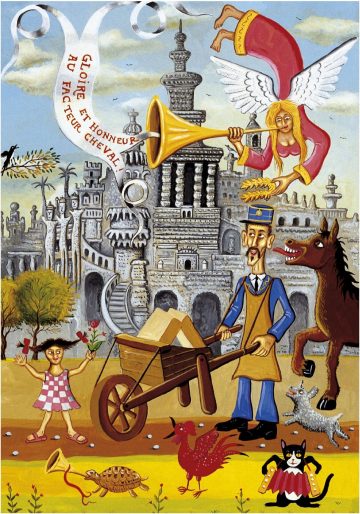Gérard LATTIER 1937
Gérard Lattier was born in 1937 in Nîmes. At the beginning, his artistic approach was described as “art noir”, representing dark and monstrous fantasies. From 1965 onwards, he adopted an imagery that was resolutely more life-oriented. A narrative painter, his writing then became rapid and naive. He depicts a popular memory, composed of stories recounting the tragedies of war in an anti-militaristic discourse. He also tells the story of the elders, or stages figures from the Occitan culture. The characters are quickly drawn and the vivid palette is full of primary colours.
His works are notably present at the Musée de l’art Brut in Lausanne (Switzerland), at the FRAC Languedoc Roussillon and at the Casey Gould Gallery, Folk Art International in New York (USA). He participated in the Biennale Hors les normes in Lyon in 2013. His work has also been exhibited at the Friche La Belle de mai in Marseille and at the Musée d’art Brut in Montpellier in 2016. More recently, the Musée des arts modestes in Sète exhibited his work in 2020.
Hommage au Facteur Cheval 2003
In his work Hommage au Facteur Cheval, the artist presented the postman in front of his building. Playing with perspectives, Gérard Lattier shows a certain precision in the representation of the three giants and the Egyptian temple. The blue sky is dotted with birds, while a whole bestiary gathers around the postman. In the foreground, the postman holds his wheelbarrow loaded with two blocks of stone. He is preceded by a little girl offering him a flower, who could be his daughter Alice. Behind him, a hilarious horse brings a touch of humour to the composition by recalling the author’s name. At his feet appears to be Mignonne, his dog. Looking up to the sky, the builder reads “Glory and honour to postman Cheval” proclaimed by Renommée who at the same time places a laurel wreath on his kepi. The colours are bright and the gesture simple. The bird sings, the feline plays the accordion and the tortoise is a trumpet player. The marvellous ensemble overflows with joie de vivre and projects us into the freshness of childhood.
Gérard Lattier explains: “I discovered the Ideal Palace when I was fifteen or sixteen years old, when it was not spoken of. I was amazed. Cheval, it’s good that he existed. It’s a universal language. But it’s a pity, Ferdinand, he’s always sulking, so I painted him with a smile! Respect, tenderness and brotherhood.

